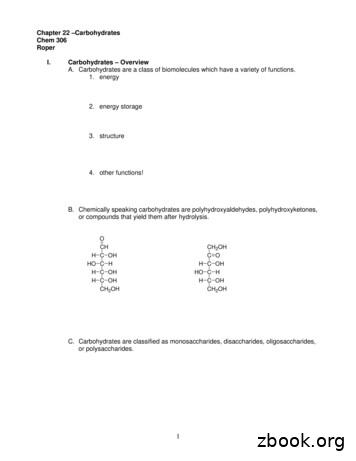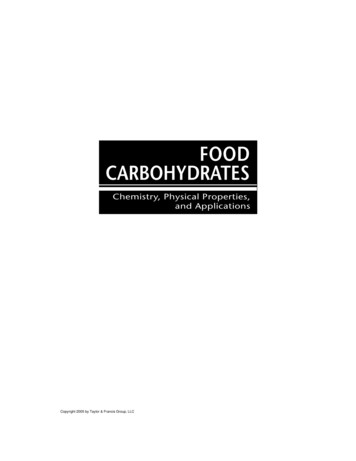An Introduction To Carbohydrates - Sinica
An Introduction to Carbohydrates Carbohydrates are a large class of naturallyoccurring polyhydroxy aldehydes andketones. Monosaccharides also known as simplesugars, are the simplest carbohydratescontaining 3-7 carbon atoms. sugar containing an aldehydes is known asan aldose. sugar containing a ketones is known as aketose.
The number of carbon atoms in analdose or ketose may be specified asby tri, tetr, pent, hex, or hept. Forexample, glucose is aldohexose andfructose is ketohexose. Monosaccharides react with each othertoformdisaccharidesandpolysaccharides. Monosaccharides are chiral moleculesand exist mainly in cyclic forms ratherthan the straight chain.
Anomers: Cyclic sugars that differs only inpositions of substituents at the hemiacetalcarbon; the -form has the –OH group onthe opposite side from the –CH2OH; the form the –OH group on the same side asthe –CH2OH group.
Some Important MonosaccharidesMonosaccharides are generally high-melting,white, crystalline solids that are soluble in waterand insoluble in nonpolar solvents.Mostmonosaccharides are sweet tasting, digestible, andnontoxic.
Polysaccharides
LectinLectins are sugar-binding proteins which are highly specific for their sugarmoieties. They typically play a role in biological recognition phenomena involvingcells and proteins. For example, some bacteria use lectins to attach themselvesto the cells of the host organism during infection.
Blood Type
DNA
In RNA, the sugar is ribose. In DNA, the sugar is deoxyribose.
Base
The following three RNA make it possible for theencoded information carried by the DNA to be putto use in the synthesis of proteins. Ribosome RNA: The granular organelles in thecell where protein synthesis takes place. Theseorganelles are composed of protein and ribosomalRNA (rRNA). Messenger RNA (mRNA): The RNA that carriesthe code transcribed from DNA and directs proteinsynthesis. Transfer RNA (tRNA): The smaller RNA thatdelivers amino acids one by one to protein chainsgrowing at ribosomes. Each tRNA recognizes andcarries only one amino acid.
Lipid Lipids are naturally occurring moleculesfrom plants or animals that are soluble innonpolar organic solvents.Lipidmoleculescontainlargehydrocarbon portion and not many polarfunctional group, which accounts for theirsolubility behavior.
Properties of cell membranes: Cell membranes are composed of a fluid likephospholipid bilayer.The bilayer incorporates cholesterol, proteins,and glycolipids.Small nonpolar molecules cross by diffusionthrough the lipid bilayer.Small ions and polar molecules diffuse throughthe aqueous media in protein pores.Glucose and certain other substances crosswith the aid of proteins without energy input.Na , K , and other substances that maintainconcentration gradients inside and outside thecell cross with expenditure of energy and theaid of proteins.
Small ions and polar molecules diffusethrough the aqueous media in proteinpores.Glucose and certain other substancescross with the aid of proteins withoutenergy input.Na , K , and other substances thatmaintain concentration gradients insideand outside the cell cross withexpenditure of energy and the aid ofproteins.
Energy and Biochemical Reactions Reactions in living organisms are similar toreactions in a chemical laboratory. Spontaneous reactions, those are favorable inthe forward direction, release free energy andthe energy released is available to do work. Spontaneous reactions , also known asexergonic reactions, are the source of ourbiochemical energy. Products of exergonic reactions are morestable than the reactants and the free energychange G has a negative value.
Photosynthesis in plants, converts CO2and H2O to glucose plus O2 which is thereverse of oxidation of glucose. The sunprovides the necessary external energyfor photosynthesis (686 kcal of freeenergy per mole of glucose formed).
The mitochondria is often called thecell’s power plants.Within themitochondria, small molecules arebroken down to provide the energy foran organism and also the principleenergy carrying molecule adenosinetriphosphate (ATP) is produced.
ATP and Energy Transfer Adenosine triphosphate (ATP) transport energyin living organisms. ATP has three –PO3- groups. Removal of one of the –PO3- groups from ATPby hydrolysis produces adenosine diphosphate(ADP). Since this reaction is an exergonicprocess, it releases energy. The reverse of ATP hydrolysis reaction isknownasphosphorylationreaction.Phosphorylation reactions are endergonic.
Biochemical energy production, transport, anduse all depends on the ATPADPinterconversions.
A few enzymes continuously cyclebetween their oxidized and reducedforms.
Acetyl-CoA 3 NAD FAD GDP Pi 2H20 CoASH 3 NADH FADH2 GTP 2CO2 3HThe citric acid cycle
The Electron-Transport Chain andATP Production Electron transport chain: The series ofbiochemical reactions that passes electronsfrom reduced coenzymes to oxygen and iscoupled to ATP formation. The electronscombine with the oxygen we breathe and withhydrogen ions from their surrounding toproduce water.Electron transport involves four enzymecomplexes held in fixed positions within theinner membrane of mitochondria and twoelectron carriers move from one complex toanother.
Pathway of electrons in electron transport
ATP Synthesis ADP is converted to ATP by a reactionbetween ADP and hydrogen phosphateion.This is both an oxidation andphosphorylation reaction. Energy releasedin the electron transport chain drives thisreaction forward.Vedio: http://www.iubmb-nicholson.org/swf/ATPSynthase.swf
Central DogmaDNAReplicationTranscriptionAIDS virusRNAProteinsTranslation
Recombinant DNABiochemistryGeneticMolecular Biology
DNA ligaseRestriction Enzyme
An Introduction to Carbohydrates Carbohydrates are a large class of naturally occurring polyhydroxy aldehydes and ketones. Monosaccharides also known as simple sugars, are the simplest carbohydrates containing 3-7 carbon atoms. sugar containing an aldehydes is known as an aldose. sugar containing a ketones is known as a ketose.
Complex Carbohydrates Include starches and some forms of fiber. About 50% of your diet should come from complex carbohydrates. Examples of foods containing complex carbohydrates include pasta, wheat, corn, vegetables, fruit, sweet potatoes, beans and grains. Simple carbohydrates Include sugars such as glucose, fructose and sucrose.
Chapter 22 -Carbohydrates Chem 306 Roper I. Carbohydrates - Overview A. Carbohydrates are a class of biomolecules which have a variety of functions. 1. energy 2. energy storage 3. structure 4. other functions! B. Chemically speaking carbohydrates are polyhydroxyaldehydes, polyhydroxyketones, or compounds that yield them after hydrolysis. CH
Carbohydrates are, in fact, an essential part of our diet; grains, fruits, and vegetables are all natural sources of carbohydrates. Carbohydrates provide energy to the body, particularly through glucose, a simple sugar that is a component of starch and an ingredient in many staple foods. Carbohydrates also have other
Carbohydrates: Complex and Simple Complex Carbohydrates are also known as starches and fibers. Complex carbohydrates in the form of starches should be included in the diet and should make up the bulk of your daily calories. Complex carbohydrates in the form of fiber should be avoided. Simple carbohydrates are also known as sugars.
Food Carbohydrates: Chemistry, Physical Properties, and Applications is intended as a comprehensive reference book for researchers, engineers, and other professionals who are interested in food carbohydrates. The layout and content of the book may be suitable as a reference or text book for advanced courses on food carbohydrates.
structures of carbohydrates are commonly represented by wedge-and-dash structures or by Fischer projections. Note that both D-glucose and D-fructose have the molecular formula C 6 H 12 O 6, consistent with the general formula C 6 H 12 O 6 which made early chemists think that those compounds were hydrates of carbon. CARBOHYDRATES 1
There are four major classes of biomolecules: i. Carbohydrates ii. Lipids iii. Proteins iv. Nucleic acids 1. Carbohydrates - Carbohydrates are good source of energy. Carbohydrates (polysaccharides) are long chains of sugars. Monosaccharides
up and as a follow-up to the 11th World Trade Organization (WTO) Ministerial Conference (MC11) in December 2017. At MC11 in Buenos Aires, differences on digital commerce could not be bridged. Views were signifi- cantly opposed. Discussions were heated. While negotiators cannot reach compromise let alone consensus, the digital economy continues to grow very fast, with major economic and .























